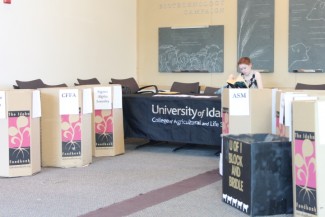CALS students collect food to help address local food issues
There are many ways to help contribute to a cause. For some students, a friendly competition offers the chance to make a difference and spend time with other like-minded students.
Student clubs in the University of Idaho College of Agricultural and Life Sciences (CALS) started a competition Monday to collect the most food donations in a week-long food drive.

Daphne Jackson | Argonaut
Rebecca Hall, a member of the Horse Polo Team, volunteers at the first day of the CALS food drive Monday in the Ag Biotech building. The food drive will continue until Friday.
“The CHS Foundation does this event called ‘Harvest for Hunger’ every year, where they work with local groups through their regional area offices to put on these food drives, and they’ll match donations,” said Ayla Neumeyer, a CALS student intern. “We were contacted to see if we’d be interested in doing something through the college … and we’re also pairing it with an event, hopefully, to help our students understand a little bit more about hunger.”
Neumeyer said club members will collect food donations in the Ag Biotech Interaction Court from 8 a.m. to 5 p.m. Monday through Friday. She said there is a bin for general food donations, but each participating club has a specific bin as well.
“The effort to get food donations is targeted at each club, but that club can then decide how they want to get that food,” Neumeyer said. “So we have one club that is going to work with local commodity groups to get food donated, we have another that’s going to work with some members in the community to help them donate to our cause, so it’s the efforts of a club towards getting food and however they want to do that.”
Seth Pratt, an advancement intern involved with the food drive, said he is working with the Idaho Food Bank. He said since the nearest office for the Idaho Food Bank is in Lewiston, most of the physical food donations would probably be sent to a local affiliate location.
“For actual food donations, you’ve got more cost in shipping it than you do in just serving it where it’s donated,” Pratt said. “The financial (donations) goes to the Idaho Food Bank directly.”
Pratt said a benefit of going through the Idaho Food Bank is its ability to make use of every penny when a monetary donation is made.
“Because they’re able to order bulk, they can create a lot more meals with a dollar than we can in going and buying everything we can at the grocery store,” he said. “So they do encourage financial gifts, rather than actual food items. But sometimes, especially when working with youth, it’s a lot more satisfying and tactile to actually bring in a food item — so both are good.”
Anna Pratt, a CALS intern in engagement, said she and other organizers reached out to all CALS student clubs — she estimated there were about 23 or 25 — and said many expressed interest, but it was hard to tell how many would actually participate until the food drive started.
She said some of the clubs chose different strategies for collecting food donations, some of which were unexpected.
“We’ve been attending some different club meetings, and I went to one the other day and they were scheming about how to get the heaviest nonperishable food items, because we’re judging it on pounds per club member,” Anna said. “But I didn’t foresee students being as creative as they are, so maybe we’ll see a lot more food than we thought we would.”
Anna said the club members would also hand out information about food insecurity in Idaho, both from the university and from the Idaho Food Bank. Food security is a USDA measurement of whether a person has regular access to food both sufficient in quantity and nutritional quality, she said.
CALS will have a related event at 6 p.m. Wednesday in Ag Sci room 62, Anna said. There will be two speakers, one from CHS and the other from the Idaho Food Bank, and they will address food insecurity in Idaho and the role agriculture students can play in helping address the problem.
Shishona Turner, CALS assistant director for college retention, said food insecurity is more of an issue than most people realize.
“Idaho is one of the most food-insecure states in the nation and Latah County is one of the most food-insecure counties of Idaho,” Turner said. “So, 18 percent of citizens in Latah County are food insecure. That, and I think two other counties have the highest percentage of the whole state.”
Daphne Jackson can be reached at [email protected]
